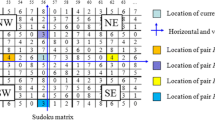Abstract
This paper proposes a reversible secret-image sharing scheme for sharing a secret image among 2n shadow images with high visual quality (i.e., they are visually indistinguishable from their original images, respectively). In the proposed scheme, not only can the secret image be completely revealed, but the original cover images can also be losslessly recovered. A difference value between neighboring pixels in a secret image is shared by 2n pixels in 2n shadow images, respectively, where n ≥ 1. A pair of shadow images which are constructed from the same cover image are called brother stego-images. To decrease pixel values changed in shadow images, each pair of brother stego-images is assigned a weighted factor when calculating difference values to be shared. A pixel in a cover image is recovered by calculating the average of corresponding pixels in its brother stego-images. A single stego-image reveals nothing and a pair of pixels in brother stego-images reveals partial difference value between neighboring secret pixels. The more brother stego-images are collected, the more information in the secret image will be revealed. Finally, a secret image will be completely revealed if all of its brother stego-images are collected.










Similar content being viewed by others
References
Chang CC, Hsieh YP, Liao CC (2011) A visual secret sharing scheme for progressively restoring secrets. Journal of Electronic Science and Technology 9(4):325–331
Chang CC, Lin CC, Lin CH, Chen YH (2008) A novel secret image sharing scheme in color images using small shadow images. Inf Sci 178(11):2433–2447
Chang CC, Lin CY, Tseng CS (2007) Secret image hiding and sharing based on t-n threshold. Fundam Inform 76(4):399–411
Chen YF, Chan YK, Huang CC, Tsai MH, Chu YP (2007) A multiple-level visual secret-sharing scheme without image size expansion. Inf Sci 177(21):4696–4710
Fang WP (2008) Friendly progressive visual secret sharing. Pattern Recogn 41(4):1410–1414
Feng JB, Wu HC, Tsai CS, Chang YF, Chu YP (2008) Visual secret sharing for multiple secrets. Pattern Recogn 41(12):3572–3581
Feng JB, Wu HC, Tsai CS, Chu YP (2005) A new multi-secret images sharing scheme using Largrange’s interpolation. J Syst Softw 76(3):327–339
Hou YC (2003) Visual cryptography for color images. Pattern Recogn 36(7):1619–1629
Hou YC, Quan ZY (2011) Progressive visual cryptography with unexpanded shares. IEEE Trans Circuits Syst Video Technol 21(11):1760–1764
Hsu HC, Chen TS, Lin YH (2004) The ringed shadow image technology of visual cryptography by applying diverse rotating angles to hide the secret sharing. In: 2004 IEEE international conference on networking, sensing and control. Taipei, Taiwan, pp 996–1001
Lin PY, Lee JS, Chang CC (2009) Distortion-free secret image sharing mechanism using modulus operator. Pattern Recogn 42(5):886–895
Lin CC, Tsai WH (2004) Secret image sharing with steganography and authentication. J Syst Softw 73(3):405–414
Liu Z, Ahmad MA, Liu S (2008) Image sharing scheme based on combination theory. Opt Commun 281(21):5322–5325
Naor M, Shamir A (1995) Visual cryptography. In: Advances in cryptology—EUROCRYPT’94. Lecture notes in computer science, vol 950. Springer, Berlin, pp 1–15
Shamir A (1979) How to share a secret. Commun ACM 22(11):612–613
Thien CC, Lin JC (2002) Secret image sharing. Comput Graph 26(5):765–770
Thien CC, Lin JC (2003) An image-sharing method with user-friendly shadow images. IEEE Trans Circuits Syst Video Technol 13(12):1161–1169
Ulutas M, Ulutas, G, Nabiyev VV (2011) Medical image security and EPR hiding using Shamir’s secret sharing scheme. J Syst Softw 84(3):341–353
Wang RZ, Shyu SJ (2007) Scalable secret image sharing. Signal Process Image Commun 22(4):363–373
Wang FH, Yen KK, Jain LC, Pan JS (2007) Multiuser-based shadow watermark extraction system. Inf Sci 177(12):2522–2532
Wang D, Zhang L, Ma N, Li X (2007) Two secret sharing schemes based on Boolean operations. Pattern Recogn 40(10):2776–2785
Wu YS, Thien CC, Lin JC (2004) Sharing and hiding secret images with size constraint. Pattern Recogn 37(7):1377–1385
Author information
Authors and Affiliations
Corresponding author
Rights and permissions
About this article
Cite this article
Lin, CC., Liao, L.H., Hwang, K.F. et al. Reversible secret-image sharing with high visual quality. Multimed Tools Appl 70, 1729–1747 (2014). https://doi.org/10.1007/s11042-012-1190-1
Published:
Issue Date:
DOI: https://doi.org/10.1007/s11042-012-1190-1




